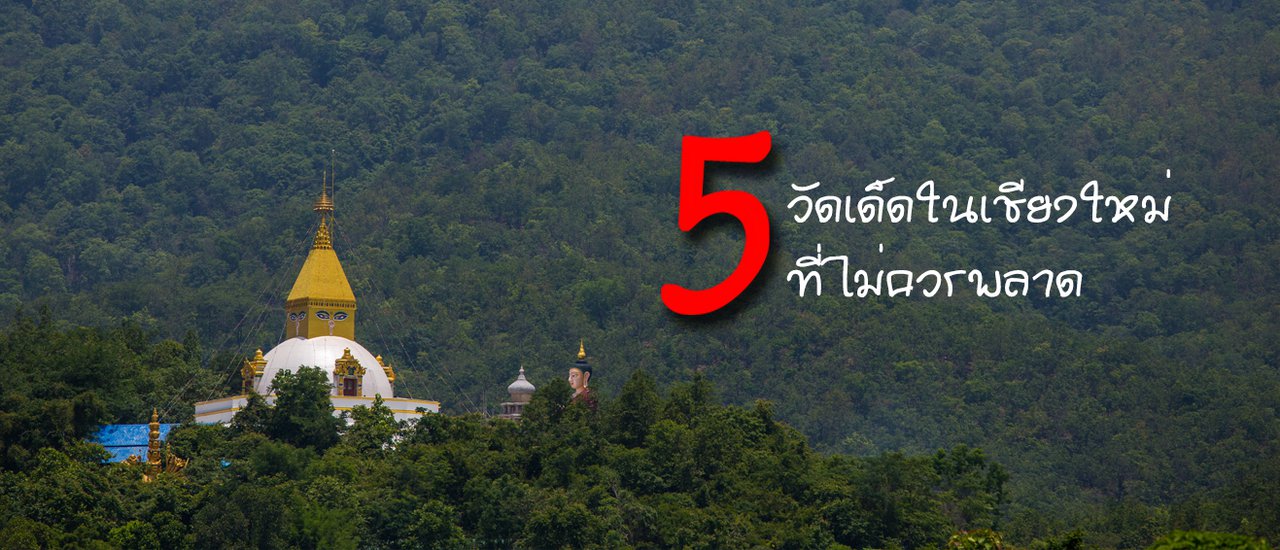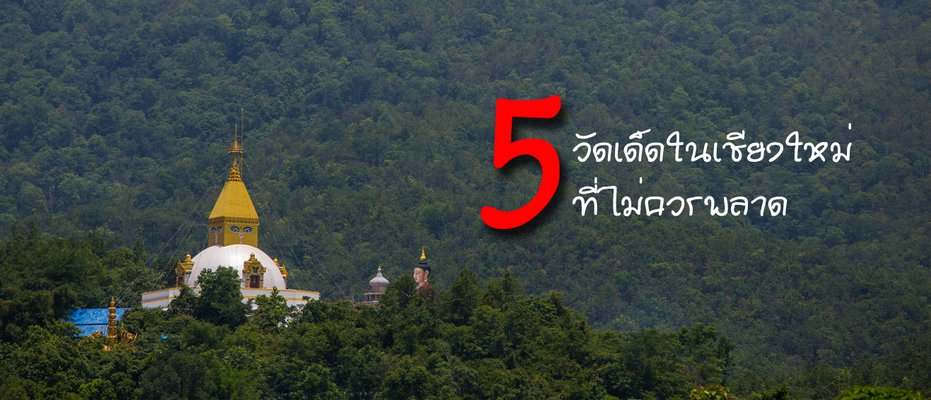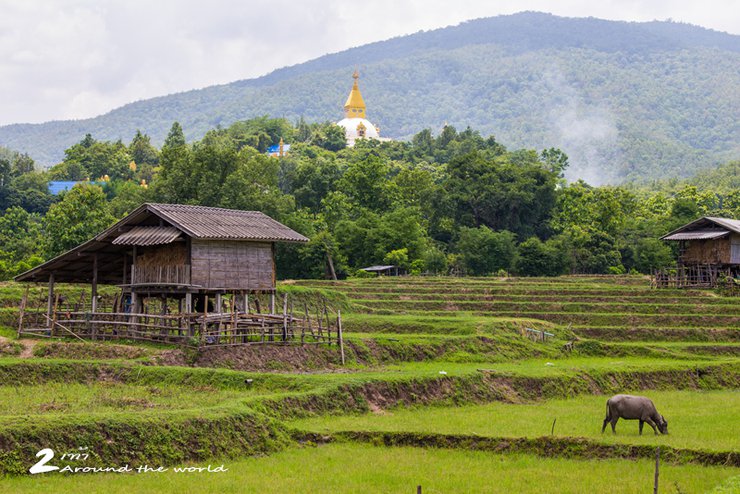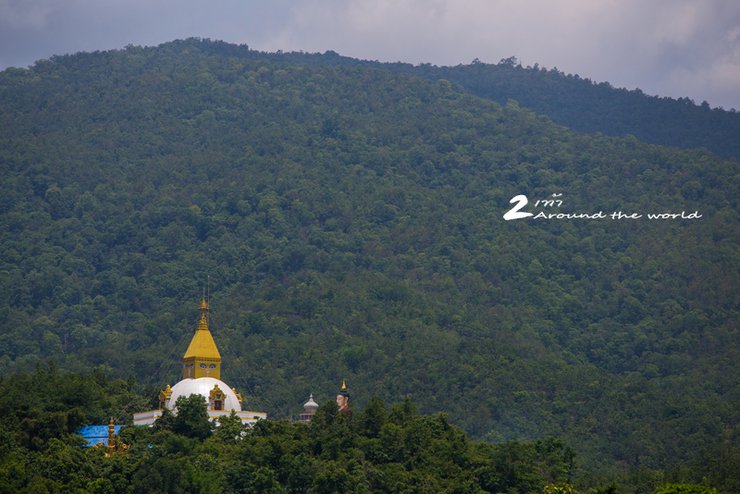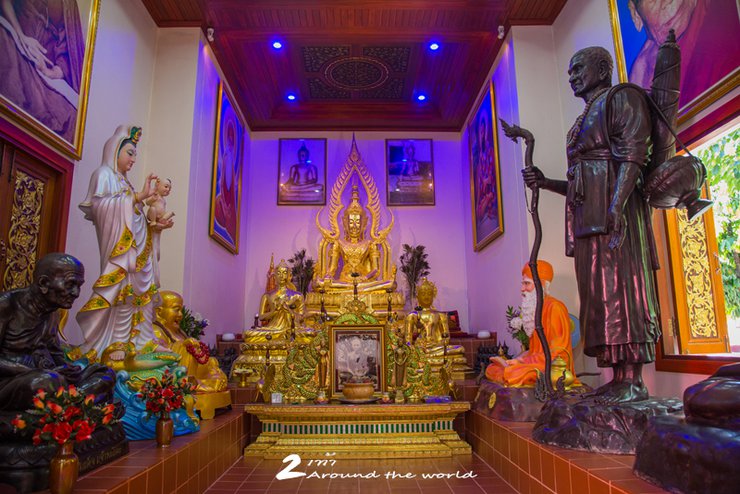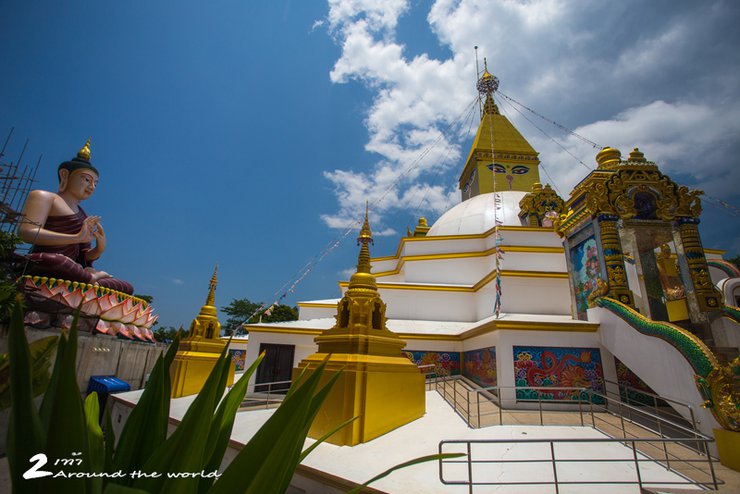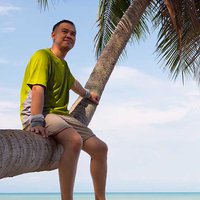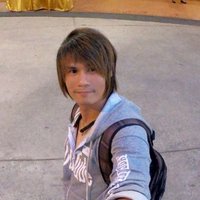
Chiang Mai, in addition to its natural beauty, also boasts a rich cultural heritage. With numerous temples, each possessing unique characteristics, Chiang Mai offers a captivating glimpse into its cultural tapestry. In this article, we will delve into five exceptional temples that should not be missed during your visit to Chiang Mai.
1. Phramthathat Phra Buddha Sathan Asrom, Chom Thong District


To reach the Phromthathada Buddhist Sanctuary, follow the same route as the Wat Phra That Sri Chom Thong Worawihan temple. After passing the temple, you will encounter the Chom Thong Police Station and a traffic light intersection. Turn right and continue straight ahead. Drive until you see a white stupa standing prominently on a low hill. The road may be a bit deserted.

Look for a sign indicating the hermitage and turn right. Continue driving and you will pass the first temple gate. There is no parking available in this area. It is recommended to drive a little further until you see a camp on the left-hand side. You can park your car at the camp, as there is no parking available inside the temple. If you park at the first gate, you will have to climb the stairs to the top. Therefore, it is recommended to park your car at the camp for convenience.

Fortunately, when I entered the temple through the first gate, there happened to be a yogini (a woman practicing meditation) sitting there. (If it were a man, he would be called a yogi.) We had a brief conversation, and I told her where I came from and how I learned about the ashram. The yogini then said that she would inform the monks who lived on the upper level to show me around the ashram.
Entering through Gate 1, I parked my car at the camp and walked a short distance. A monk was waiting to greet me at the front. It's important to note that the ashram has one rule for visitors: no meat, eggs, or any type of drugs or intoxicants are allowed on the premises.
In 2004, village headman Pan, along with local villagers, invited "Kruba Traitep Jantuwano" to reside at the Phromthatha Buddha Sanctuary. At that time, Kruba Traitep was residing at the Huay Bong Monastery in Doi Lo District, Chiang Mai Province. Devotees collaborated to construct living quarters, meditation facilities, and various permanent structures, which remain in use today.
The monk first led me to pay respects to the Buddha statues. Inside, there were Buddha statues, statues of revered monks, statues of the Goddess of Mercy, and even deities from Hinduism.


The next point of interest that drew me here is the Phra Maha Chedi Triratna Buddhayan Rangsri Pathum Mongkol, a grand stupa modeled after the Boudhanath Stupa in Kathmandu, Nepal. Boudhanath translates to "Lord of Awakening," signifying the Buddha as a source of refuge.

The front of the Great Stupa features statues of Hindu deities.



The Triratna Buddhayan Rangsi Pathum Mongkol Maha Chedi was constructed in 2006. The base of the stupa resembles a lotus bud, reflecting Tibetan architectural influences. This is evident in the construction style of the stupa base, which draws inspiration from the enigmatic mandala, a symbolic representation of enlightened consciousness in Tibetan Buddhism. The mandala signifies the dwelling place of Buddhas and Bodhisattvas during their state of enlightenment.

The Triratna Buddhayan Rangsi Pathum Mongkol Maha Chedi was constructed in 2006. The base of the stupa resembles a lotus bud, reflecting Tibetan architectural influences. This is evident in the construction style of the stupa base, which draws inspiration from the enigmatic mandala, a symbolic representation of the enlightened mind in Tibetan Buddhism. The mandala signifies the dwelling place of Buddhas and Bodhisattvas during their state of enlightenment.

Two beautifully decorated guardian figures, each with intricate patterns and vibrant colors, stand at the base of each of the four archways.

The surrounding area of the pagoda offers panoramic views, but the most striking angle in my opinion is this one, which also captures the beauty of the rice terraces.


The interior of the Phra Maha Chedi Pagoda houses a statue of "Phra Buddha Sattanakara Raja Chandra Prabhat Tathagata" in the Naga subduing posture, adorned with the regalia of a great emperor. The majestic king, the lord of the three worlds, sits on a lotus throne atop seven seven-headed nagas.

This stupa enshrines the sacred relics of the Buddha, including the right jawbone, hair, rib, skull, and soft tissues such as flesh, skin, liver, kidneys, and stomach. It also contains the relics of prominent arhats, including Moggallana, Sariputta, Ananda, Rahula, and Sivali.

The walls are adorned with exquisite Tibetan Buddhist murals depicting various Buddhas and Bodhisattvas.

The side of the Phra Maha Chedi is the location of the Phra Trai Lokanath, whose face appears to be full of joy.




The monk then led me to another spot to pay respects to the deities. Inside, there were statues of Hindu deities such as Brahma, Shiva, and Vishnu, as well as statues of Chinese deities and prophets of Christianity. Kruba Jantra Tepa explained that the reason for creating these statues was to avoid limiting the focus solely to Buddhist monks or practitioners.

The remains of Luang Pu Chanta Anakulo, the former abbot of Wat Pa Kasem Suk in Kabin Buri district, Prachin Buri province, are enshrined at this hermitage. Some may wonder why his remains are not at Wat Pa Kasem Suk. The reason is that Luang Pu Chanta had a vision of his deceased teacher reincarnated as a young monk in the north. When Luang Pu Chanta saw a photograph of Khru Ba Chai Trai Thep, he knew through his intuition that this was his former teacher. Later, when Luang Pu Chanta became seriously ill, he instructed his close disciples that if he died, his remains should be brought to this hermitage so that he could be with Khru Ba Chai Trai Thep.

The hermitage also houses many other interesting spots. However, due to my limited time, the monk took me to another noteworthy location: the replica cave. Inside, the ashes of the relics are also enshrined.
This is another interesting place in Chom Thong district besides Phra That Chom Thong. If any friends pass by Chom Thong, try to visit and experience the unique art that is rarely seen in Thailand.
2. Wat Umong
Wat Umong is another significant temple in Chiang Mai, designed according to the Sri Lankan Buddhist tradition. Later, a tunnel was built within the temple grounds, hence the name Wat Umong (meaning "tunnel temple").

As Wat Umong serves as a meditation retreat, the atmosphere is serene and shaded by large trees, creating a refreshingly tranquil environment.
This staircase corner gives the impression of being in Bali.

The most interesting feature of Wat Umong is the 700-year-old tunnel under the pagoda, which is not found in other temples.

During the rainy season, the tunnel walls are covered in moss, resembling a carpeted wall.




Beneath the pagoda, there are four interconnected tunnels, although only three are visible from the front wall. Stepping into the tunnels feels like stepping back in time. The tunnel ceilings reveal traces of oil paintings, heavily damaged and faded.

The tunnel's ceiling features an ancient Lanna-style pagoda. The bell-shaped pagoda resembles overlapping lotus petals, culminating in a spire. This architectural style reflects the influence of Bagan art.
The Tunnel Temple, also known as Wat Umong, is a unique and must-visit destination in Chiang Mai. Its distinctive architecture, featuring tunnels and underground chambers, sets it apart from other temples in the region. The temple's convenient location, situated behind Chiang Mai University, makes it easily accessible to visitors.
3. Wat Si Suphawan
Wat Sri Suphan, built in 1400, is another ancient temple in Chiang Mai, located in the Wualai Road area.





The interior of the Lanna-style viharn houses a large Buddha statue in the Marawijai posture. The murals on the walls depict stories from the life of the Buddha and his previous lives. The pillars are adorned with intricate gold patterns, resembling important pagodas.

Next to the Lanna-style wiharn is the ho trai, which stands alongside the silver-plated ubosot. It was this very ubosot that drew me to Wat Sri Suphan.



This newly constructed ordination hall replaces the dilapidated original structure. The restoration employed silver and tin as primary materials, leveraging the expertise and ingenuity of local silversmiths renowned for their craftsmanship. Consequently, this ordination hall stands as the first silver ordination hall in the Lanna architectural style in Thailand.







The exterior of the ordination hall, including the roof, is adorned with intricately patterned silverware. The rear features embossed patterns that narrate the story of the Buddha's life and the history of Phra Chao Chet Tue.

The entrance archway features embossed wire designs of deities in a prayer position.


The upper part of the left and right wings are beautifully replicated as 1,000 baht banknotes.



Inside the ordination hall, the miraculous Buddha statue (Phra Chao Chet Tue), a bronze Buddha statue in the posture of subduing Mara, is enshrined. Its aura shines brightly, standing out against the patterns of the silver sheet. It is truly magnificent.
Upon closer inspection of the left foot of the Phra Chao Chet Thip statue, one can discern traces of bullet holes dating back to World War II. This is attributed to the fact that Wat Si Suphan once served as a stronghold for the Japanese military, with the Ho Trai (library building) being used as a command center. During an enemy attack, bullets struck the left foot of the statue, leaving visible marks that remain to this day.

The interior walls of the ubosot are adorned with the cremains of numerous monks.

On the day of my visit, I witnessed skilled artisans meticulously embossing intricate patterns onto silver sheets near the Lanna-style viharn. Their craftsmanship in creating this silver ordination hall is truly remarkable. Each intricate design requires meticulous attention to detail. If you ever find yourself in Chiang Mai, I highly recommend visiting this magnificent silver ordination hall. Its beauty is sure to leave you in awe.
4. Wat Phra Singh Woramahawihan
Wat Phra Singh Woramahawihan is a first-class royal temple and is considered the main temple for those born in the year of the Dragon. Visiting this temple is believed to bring great fortune, longevity, and prosperity.



The ubosot houses the Phra Singh (Phra Buddha Sihing), a sacred Buddha image revered as the guardian of Chiang Mai and the Lanna Kingdom. This image exemplifies the Chiang Saen art style. The wihan (chapel) is renowned for its unique murals depicting the stories of Suphannahong and Sangthong, found exclusively at this temple.

The side of the ordination hall reveals large windows resembling wooden lattices, but inside are actual windows adorned with intricate and beautiful murals.

The ornately gilded doors and windows are truly magnificent.

5. Wat Chedi Luang



Wat Chedi Luang: A Historical Jewel of Chiang Mai
Wat Chedi Luang, an ancient royal temple, stands as a testament to Chiang Mai's rich history. Its impressive stupa, considered one of the most significant in the city, has undergone numerous renovations throughout the centuries. While my late arrival prevented me from exploring the temple's various offerings, including the stupa, the Inthakhin, the Yhang Kumphan tree, and the Phra Rishi statue, I was able to appreciate the majestic stupa from afar.
The Phra Chedi Luang, constructed in 1934, stands at an impressive 80 meters tall. Its square base measures 56 meters on each side, resembling the metallic prasat style of Sri Lanka. The stupa's design incorporates elements of the Bagan style, with modified niches at the four corners adorned by 28 elephant statues encircling the structure.
When visiting Chiang Mai, be sure to experience the unique charm of these five remarkable temples.
Finally, you can show your support and follow my work on https://www.facebook.com/unclegreenshirt.
ลุงเสื้อเขียว
Tuesday, October 8, 2024 11:20 AM

